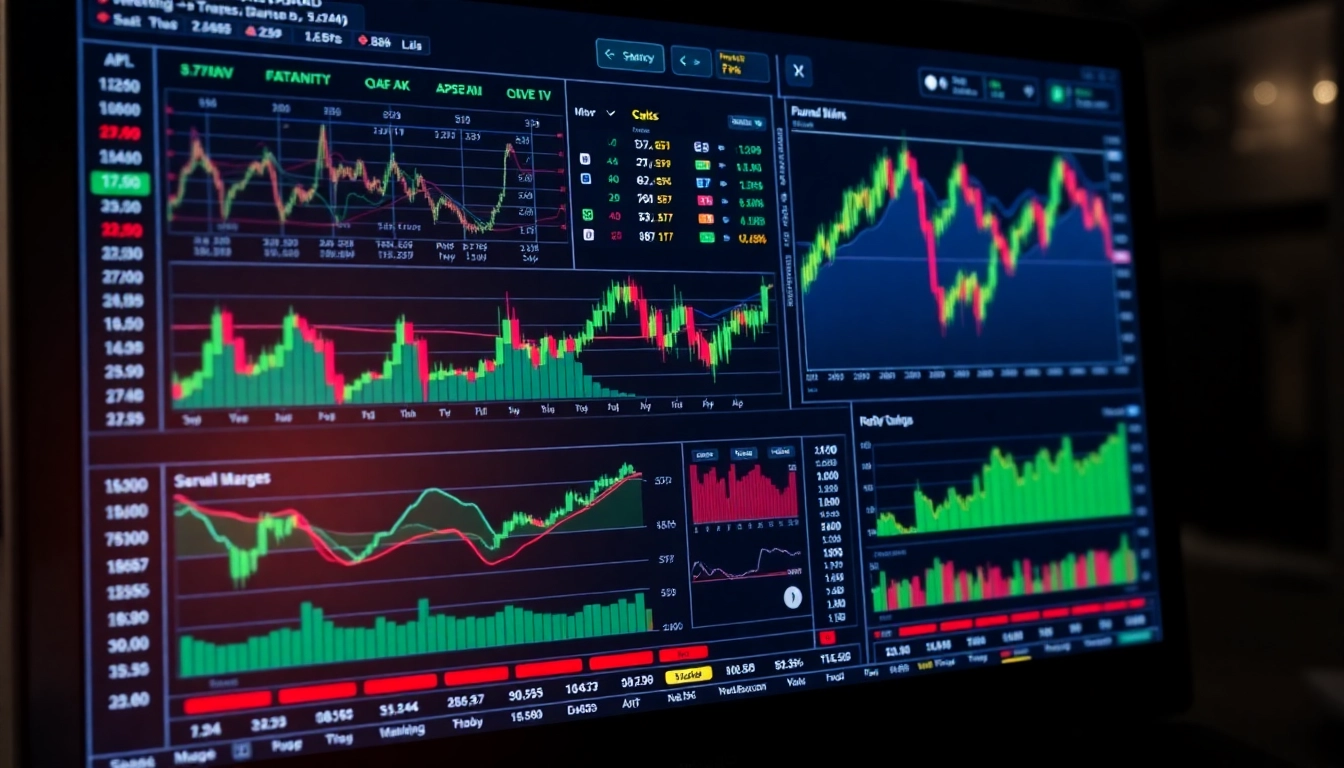Understanding Trading View and Its Core Functionality
What is Trading View and Why It Matters
In today’s highly dynamic financial markets, the ability to analyze and interpret complex data swiftly is crucial for traders and investors alike. trading view has emerged as a cornerstone platform that amalgamates advanced charting tools, social networking, and real-time market data into one cohesive environment. This platform is vital because it democratizes access to professional-grade analysis, allowing both retail traders and institutional investors to make informed decisions. Its versatility spans various markets—from stocks and forex to cryptocurrencies and commodities—making it an indispensable tool for market participants looking to stay ahead in a volatile landscape.
TradingView’s significance extends beyond mere charting; it fosters a collaborative community, encourages shared insights, and offers customizable tools that adapt to diverse trading strategies. Its cloud-based infrastructure ensures accessibility across devices, empowering traders to monitor the markets anytime, anywhere. This seamless integration enhances strategic planning and real-time decision-making, which are critical for capitalizing on fleeting market opportunities.
Key Features and Tools for Traders
TradingView is renowned for its extensive suite of features designed to optimize trading efficiency and accuracy. Central among these are its versatile charting tools—offering over 100 technical indicators, drawing tools, and multiple chart types such as candlestick, bar, and line charts. Traders can create highly tailored setups, applying overlays and annotations that suit their unique analysis styles.
Alerts form another core component, enabling users to set precise notifications based on price levels, indicator movements, or pattern recognitions. This proactive feature ensures traders do not miss critical market signals, facilitating timely actions without constant monitoring.
Additionally, TradingView’s social features set it apart. Users can publish their analyses, follow leading traders, and engage in discussions that enhance learning and strategic refinement. The platform also automatically saves personalized charts and settings, allowing a consistent trading environment that can be revisited or shared effortlessly.
For traders seeking automation, TradingView provides scripting capabilities through its proprietary Pine Script language. This allows creation of custom indicators, strategies, and backtesting routines, thereby elevating analytical depth and strategic sophistication.
How Trading View Differentiates from Competitors
While several platforms offer charting and analysis, TradingView distinguishes itself through a combination of accessibility, community integration, and technological robustness. Unlike standalone desktop applications, TradingView is cloud-based, eliminating compatibility and update concerns, while providing instant access across devices.
Its social ecosystem promotes a collaborative approach to trading, where ideas, strategies, and market forecasts are openly shared, creating a vibrant community of over 60 million traders worldwide. This social dimension not only democratizes market insights but also fosters accountability and peer learning.
Moreover, TradingView’s extensive market coverage surpasses many competitors—enabling real-time tracking of stocks, cryptocurrencies, indices, futures, options, and more—within an intuitive interface. Its affordability, flexible subscription plans, and free tier make professional-grade tools accessible to a diverse user base.
Competitors such as MetaTrader or Thinkorswim excel in desktop functionalities but often lack the unified social platform or cross-device flexibility that TradingView offers. As a result, TradingView’s holistic approach positions it as a leader in modern trading analysis.
Getting Started with Trading View: Setup and Customization
Creating and Configuring Your Trading Dashboard
Initiating your journey with TradingView begins with creating a free account, which unlocks a multitude of features. Once registered, you can customize your dashboard by adding various charts, watchlists, and market widgets. Drag-and-drop functionality simplifies layout adjustments, enabling traders to prioritize tools critical to their strategies.
Importantly, traders should organize their workspace around the markets and timeframes they monitor most frequently. For example, keeping a dedicated Bitcoin chart alongside a currency pair’s technical analysis streamlines decision-making. Saving these configurations allows quick retrieval and consistency in analysis.
Personalizing Charts and Alerts for Your Trading Style
Personalization enhances analytical precision. Traders can apply default indicators or create custom templates, ensuring that each chart reflects their preferred analytical approach. Setting alerts based on specific price targets, indicator thresholds, or pattern formations helps automate vigilance—critical for capturing fleeting market moves.
A practical tip is to utilize color-coding and annotation tools to highlight key levels or patterns, fostering faster recognition during live analysis. Additionally, integrating notifications via email, SMS, or app alerts ensures that traders stay informed without constantly checking screens.
Integrating Trading View with Your Trading Accounts
For a seamless trading experience, TradingView offers integration with multiple brokerage accounts—though compatibility varies. Many brokerage platforms now support direct trading from the chart interface, reducing order execution times. To connect, users typically authorize their brokerage accounts within TradingView’s trading panel, following straightforward prompts.
Before integration, it’s advisable to verify account security and ensure trading permissions align with your risk management protocols. Proper synchronization not only streamlines order placement but also facilitates real-time trade monitoring and quick adjustments.
Advanced Techniques for Market Analysis Using Trading View
Technical Analysis and Chart Patterns
Power users leverage TradingView’s rich charting capabilities to identify continuation and reversal patterns such as head and shoulders, double tops/bottoms, and triangles. Combining pattern recognition with trendline analysis provides insights into potential breakout or breakdown points.
For example, utilizing the platform’s drawing tools, traders can mark support and resistance levels, then watch for price actions crossing these thresholds. Backtest these patterns within the platform to validate their predictive power, enhancing trading confidence.
Using Indicators and Oscillators Effectively
TradingView’s library of over 100 technical indicators includes Moving Averages, RSI, MACD, Bollinger Bands, and Fibonacci Retracements. Effective traders combine multiple indicators to confirm signals—e.g., using RSI divergence alongside MACD crossovers to filter false entries.
Analytical accuracy benefits from indicator customization, such as adjusting periods or thresholds. Combining trend-following tools with oscillators helps assess market momentum and overbought/oversold conditions, supporting well-rounded decision-making.
Real-Time Data and Alert Management
Real-time data feeds are essential for timely trading. TradingView offers access to live prices across numerous exchanges, reducing latency and enabling rapid responses. Effective alert management entails setting multiple alerts at critical levels, with layered conditions to avoid false signals.
Organizing alerts into categories—such as breakout signals, trend confirmations, or volume spikes—improves workflow clarity. Regularly reviewing and refining alert parameters ensures they evolve with market conditions, maintaining their relevance.
Maximizing Trading View for Successful Trading Strategies
Developing and Testing Trading Strategies
Strategy development starts with identifying core signals and defining entry/exit rules. Using TradingView’s Pine Script, traders can automate these strategies, backtest them across historical data, and refine parameters for optimal performance.
Simulated trading within the platform helps quantify risk-reward profiles and identify weaknesses before live deployment. Consistent documentation of strategy rules fosters disciplined trading and reduces emotional biases.
Community Insights and Social Trading Features
TradingView’s social aspect offers valuable peer insights. Traders can publish their analyses, view others’ setups, and participate in discussion threads. These interactions often reveal market sentiments or emerging trends, adding layers of contextual understanding.
Following top analysts and subscribing to their ideas can accelerate learning. Engaging with the community also provides feedback on your strategies, fostering continuous improvement.
Monitoring Performance and Refining Techniques
Continuous performance tracking allows traders to evaluate the efficacy of their strategies. TradingView’s performance analysis tools log metrics such as win rate, profit factor, and drawdowns—facilitating data-driven adjustments.
Establishing a trading journal within the platform helps document reasoning behind trades, learning from successes and failures. Over time, iterative refinements based on real data enhance consistency and profitability.
Future Trends and Upgrades in Trading View
Upcoming Features and Innovations
TradingView continually evolves by integrating new features like AI-driven predictive models, expanded asset coverage, and enhanced charting capabilities. Upcoming updates aim to incorporate machine learning tools that can offer deeper insights and automated signals.
Enhanced mobile functionalities and simplified user interfaces are also on the horizon, catering to a broader demographic of traders seeking quick, actionable insights on the go.
How Trading View Is Evolving with Market Demands
As markets become more interconnected and technology-driven, TradingView adapts by offering real-time multi-exchange data, seamless integration with brokerage accounts, and social features that promote transparency and shared wisdom.
The platform’s focus on community, advanced analytics, and mobile accessibility ensures it remains aligned with traders’ needs in an era of rapid market shifts.
Adapting Strategies to New Market Technologies
Staying ahead requires traders to leverage innovations like algorithmic trading, API integrations, and AI-based predictive analytics within TradingView. Developing skills in scripting and data analysis enables traders to customize tools and algorithms, boosting their edge.
Embracing these technological advances ensures that traders not only keep up with but also capitalize on emerging market dynamics, transforming data into actionable strategies.



